Vibration Suppression of a Flexible Beam Structure Coupled with Liquid Sloshing via ADP Control Based on FBG Strain Measurement
Abstract
:1. Introduction
- (1)
- Compared with complex dynamic models, the Euler–Bernoulli beam model and spring-mass-damper equivalent model provide a simpler and more convenient way to construct the flexible-sloshing coupling dynamic model. The development of a strain-based vibration dynamic model facilitates the full utilization of FBG sensors’ information.
- (2)
- Compared with control methods that require motion parameters, the control method proposed in this paper can effectively suppress elastic vibration and sloshing even when only partial strain information is applied. Furthermore, the utilization of FBG strain information allows for direct measurement, eliminating the need for estimation of vibration parameters. This controller’s advantages in practicality make it highly suitable for engineering applications.
2. Preliminaries and System Descriptions
2.1. Flexible-Sloshing Coupling Dynamic Model
2.2. Strain-Based Vibration Dynamic Model
3. Control Strategy Design
3.1. Design of ADP Control Method Based on Strain Information of FBG
3.2. Stability Analysis
4. Numerical Simulations
5. Conclusions
- (1)
- The usages of the Euler–Bernoulli beam model and the spring-mass-damper equivalent model provide a simpler and more convenient way for constructing the flexible-sloshing coupling dynamic model.
- (2)
- The development of a strain-based vibration dynamic model facilitates the full utilization of FBG sensors’ strain information.
- (3)
- This controller can effectively suppress elastic vibration and sloshing with only partial strain information, eliminating the process of estimating the vibration motion parameters. The control strategy indicates important implications in engineering applications.
Author Contributions
Funding
Data Availability Statement
Conflicts of Interest
References
- Guo, S.-S.; Kim, J. Some Recent Developments in the Vibration Control and Structure Health Monitoring. Actuators 2023, 12, 11. [Google Scholar] [CrossRef]
- He, G.; Cao, D. Dynamic Modeling and Attitude-Vibration Cooperative Control for a Large-Scale Flexible Spacecraft. Actuators 2023, 12, 167. [Google Scholar] [CrossRef]
- Dai, J.; Qin, Y.; Wang, C.; Zhu, J.; Zhu, J. Research on Stability Control Technology of Hazardous Chemical Tank Vehicles Based on Electromagnetic Semi-Active Suspension. Actuators 2023, 12, 333. [Google Scholar] [CrossRef]
- Su, W.; King, C.K.; Clark, S.R.; Griffin, E.D.; Suhey, J.D.; Wolf, M.G. Dynamic Beam Solutions for Real-Time Simulation and Control Development of Flexible Rockets. J. Spacecr. Rocket. 2017, 54, 403–416. [Google Scholar] [CrossRef]
- Peterson, L.D.; Crawley, E.F.; Hansman, R.J. Nonlinear fluid slosh coupled to the dynamics of a spacecraft. AIAA J. 1989, 27, 1230–1240. [Google Scholar] [CrossRef]
- Frosch, J.A.; Vallely, D.P. Saturn AS-501/S-IC flight control system design. J. Spacecr. Rocket. 1967, 4, 1003–1009. [Google Scholar] [CrossRef]
- Unruh, J.F.; Kana, D.D.; Dodge, F.T.; Fey, T.A. Digital data analysis techniques for extraction of slosh model parameters. J. Spacecr. Rocket. 1986, 23, 171–177. [Google Scholar] [CrossRef]
- Guo, N.; Yang, Z.; Wang, L.; Ouyang, Y.; Zhang, X. Dynamic model updating based on strain mode shape and natural frequency using hybrid pattern search technique. J. Sound Vib. 2018, 422, 112–130. [Google Scholar] [CrossRef]
- Mooij, E.; Gransden, D.I. The Effect of Sloshing on the Controllability of a Conventional Aeroelastic Launch Vehicle. In AIAA Scitech 2019 Forum; AIAA SciTech Forum; American Institute of Aeronautics and Astronautics: Reston, VA, USA, 2019. [Google Scholar]
- Panopoulou, A.; Roulias, D.; Loutas, T.H.; Kostopoulos, V. Health Monitoring of Aerospace Structures Using Fibre Bragg Gratings Combined with Advanced Signal Processing and Pattern Recognition Techniques. Strain 2012, 48, 267–277. [Google Scholar] [CrossRef]
- Chuang, K.; Lin, S.; Ma, C.; Wu, R. Application of a Fiber Bragg Grating-Based Sensing System on Investigating Dynamic Behaviors of a Cantilever Beam Under Impact or Moving Mass Loadings. IEEE Sens. J. 2013, 13, 389–399. [Google Scholar] [CrossRef]
- Kong, C.; Zhao, D.; Zhang, J.; Liang, B. Real-Time Virtual Sensing for Dynamic Vibration of Flexible Structure via Fiber Bragg Grating Sensors. IEEE Sens. J. 2022, 22, 21706–21718. [Google Scholar] [CrossRef]
- Abramson, H.N. The Dynamic Behavior of Liquids in Moving Containers With Applications to Space Vehicle Technology; NASA: Washington, DC, USA, 1966.
- Su, N.; Bian, J.; Peng, S.; Chen, Z.; Xia, Y. Balancing static and dynamic performances of TMD with negative stiffness. Int. J. Mech. Sci. 2023, 243, 108068. [Google Scholar] [CrossRef]
- Chen, Z.; Chen, Z.; Wei, Y. Quasi-Zero Stiffness-Based Synchronous Vibration Isolation and Energy Harvesting: A Comprehensive Review. Energies 2022, 15, 7066. [Google Scholar] [CrossRef]
- Kapasakalis, K.A.; Antoniadis, I.A.; Sapountzakis, E.J. Performance assessment of the KDamper as a seismic Absorption Base. Struct. Control. Health Monit. 2020, 27, e2482. [Google Scholar] [CrossRef]
- Kapasakalis, K.A.; Antoniadis, I.A.; Sapountzakis, E.J. Constrained optimal design of seismic base absorbers based on an extended KDamper concept. Eng. Struct. 2021, 226, 111312. [Google Scholar] [CrossRef]
- Wang, J.; Liu, J.; Li, Y.; Chen, C.L.P.; Liu, Z.; Li, F. Prescribed Time Fuzzy Adaptive Consensus Control for Multiagent Systems With Dead-Zone Input and Sensor Faults. IEEE Trans. Autom. Sci. Eng. 2023, 21, 1–12. [Google Scholar] [CrossRef]
- Wang, J.; Gong, Q.; Huang, K.; Liu, Z.; Chen, C.L.P.; Liu, J. Event-Triggered Prescribed Settling Time Consensus Compensation Control for a Class of Uncertain Nonlinear Systems With Actuator Failures. IEEE Trans. Neural Networks Learn. Syst. 2023, 34, 5590–5600. [Google Scholar] [CrossRef]
- Wang, J.; Wang, C.; Liu, Z.; Chen, C.L.P.; Zhang, C. Practical Fixed-Time Adaptive ERBFNNs Event-Triggered Control for Uncertain Nonlinear Systems With Dead-Zone Constraint. IEEE Trans. Syst. Man Cybern. Syst. 2023, 54, 1–10. [Google Scholar] [CrossRef]
- Goh, C.J.; Caughey, T.K. On the stability problem caused by finite actuator dynamics in the collocated control of large space structures. Int. J. Control 1985, 41, 787–802. [Google Scholar] [CrossRef]
- Mahmoodi, S.N.; Ahmadian, M. Active Vibration Control With Modified Positive Position Feedback. J. Dyn. Syst. Meas. Control 2009, 131, 041002. [Google Scholar] [CrossRef]
- Lieven, N.A.J.; Ewins, D.J.; Inman, D.J. Active modal control for smart structures. Philos. Trans. R. Soc. London. Ser. A Math. Phys. Eng. Sci. 2001, 359, 205–219. [Google Scholar] [CrossRef]
- Baz, A.; Poh, S. Performance of an active control system with piezoelectric actuators. J. Sound Vib. 1988, 126, 327–343. [Google Scholar] [CrossRef]
- Wang, Z.; Wu, W.; Görges, D.; Lou, X. Sliding mode vibration control of an Euler–Bernoulli beam with unknown external disturbances. Nonlinear Dyn. 2022, 110, 1393–1404. [Google Scholar] [CrossRef]
- He, W.; Ge, S.S. Vibration Control of a Flexible Beam With Output Constraint. IEEE Trans. Ind. Electron. 2015, 62, 5023–5030. [Google Scholar] [CrossRef]
- Ma, Y.; Lou, X.; Miller, T.; Wu, W. Fault-Tolerant Boundary Control of an Euler–Bernoulli Beam Subject to Output Constraint. IEEE Trans. Syst. Man Cybern. Syst. 2023, 53, 4753–4763. [Google Scholar] [CrossRef]
- Feng, Y.; Liu, Z. Adaptive Vibration Iterative Learning Control of an Euler–Bernoulli Beam System With Input Saturation. IEEE Trans. Syst. Man Cybern. Syst. 2023, 53, 2469–2477. [Google Scholar] [CrossRef]
- Mirafzal, S.H.; Khorasani, A.M.; Ghasemi, A.H. Optimizing time delay feedback for active vibration control of a cantilever beam using a genetic algorithm. J. Vib. Control 2015, 22, 4047–4061. [Google Scholar] [CrossRef]
- Lin, J.; Chao, W.S. Vibration Suppression Control of Beam-cart System with Piezoelectric Transducers by Decomposed Parallel Adaptive Neuro-fuzzy Control. J. Vib. Control 2009, 15, 1885–1906. [Google Scholar] [CrossRef]
- He, W.; Gao, H.; Zhou, C.; Yang, C.; Li, Z. Reinforcement Learning Control of a Flexible Two-Link Manipulator: An Experimental Investigation. IEEE Trans. Syst. Man Cybern. Syst. 2021, 51, 7326–7336. [Google Scholar] [CrossRef]
- Qiu, Z.-c.; Yang, Y.; Zhang, X.-m. Reinforcement learning vibration control of a multi-flexible beam coupling system. Aerosp. Sci. Technol. 2022, 129, 107801. [Google Scholar] [CrossRef]
- Wang, F.Y.; Zhang, H.; Liu, D. Adaptive Dynamic Programming: An Introduction. IEEE Comput. Intell. Mag. 2009, 4, 39–47. [Google Scholar] [CrossRef]
- Jiang, H. Real Time Mode Sensing and Attitude Control of Flexible Launch Vehicle with Fiber Bragg Grating Sensor Array; Florida Institute of Technology: Melbourne, FL, USA, 2011. [Google Scholar]
- Orr, J.S. Robust Autopilot Design for Lunar Spacecraft Powered Descent Using High Order Sliding Mode Control; The University of Alabama in Huntsville: Huntsville, AL, USA, 2009. [Google Scholar]
- Kwon, Y.W.; Bang, H. The Finite Element Method Using MATLAB; London CRC Press: Boca Raton, FL, USA, 2000. [Google Scholar]
- Ibrahim, R.A. Liquid Sloshing Dynamics: Theory and Applications; Cambridge University Press: New York, NY, USA, 2005. [Google Scholar]
- Dodge, F.T. Analytical Representation of Lateral Sloshing by Equivalent Mechanical Models; NASA Special Publication: Washington, DC, USA, 1966; p. 199.
- Song, X.; Liang, D. Dynamic displacement prediction of beam structures using fiber bragg grating sensors. Optik 2018, 158, 1410–1416. [Google Scholar] [CrossRef]
- Wu, S.Q.; Zhou, J.X.; Rui, S.; Fei, Q.G. Reformulation of elemental modal strain energy method based on strain modes for structural damage detection. Adv. Struct. Eng. 2017, 20, 896–905. [Google Scholar] [CrossRef]
- Zhao, D.-J.; Wang, Y.-J.; Liu, L.; Wang, Z.-S. Robust Fault-Tolerant Control of Launch Vehicle Via GPI Observer and Integral Sliding Mode Control. Asian J. Control 2013, 15, 614–623. [Google Scholar] [CrossRef]
- Zhong, X.; He, H. An Event-Triggered ADP Control Approach for Continuous-Time System With Unknown Internal States. IEEE Trans. Cybern. 2017, 47, 683–694. [Google Scholar] [CrossRef]
- Igelnik, B.; Yoh-Han, P. Stochastic choice of basis functions in adaptive function approximation and the functional-link net. IEEE Trans. Neural Netw. 1995, 6, 1320–1329. [Google Scholar] [CrossRef]
- Liu, F.; Sun, J.; Si, J.; Guo, W.; Mei, S. A boundedness result for the direct heuristic dynamic programming. Neural Netw. 2012, 32, 229–235. [Google Scholar] [CrossRef]
- Khalil, H.K. Nonlinear Systems; Prentice Hall: Upper Saddle River, NJ, USA, 2002. [Google Scholar]
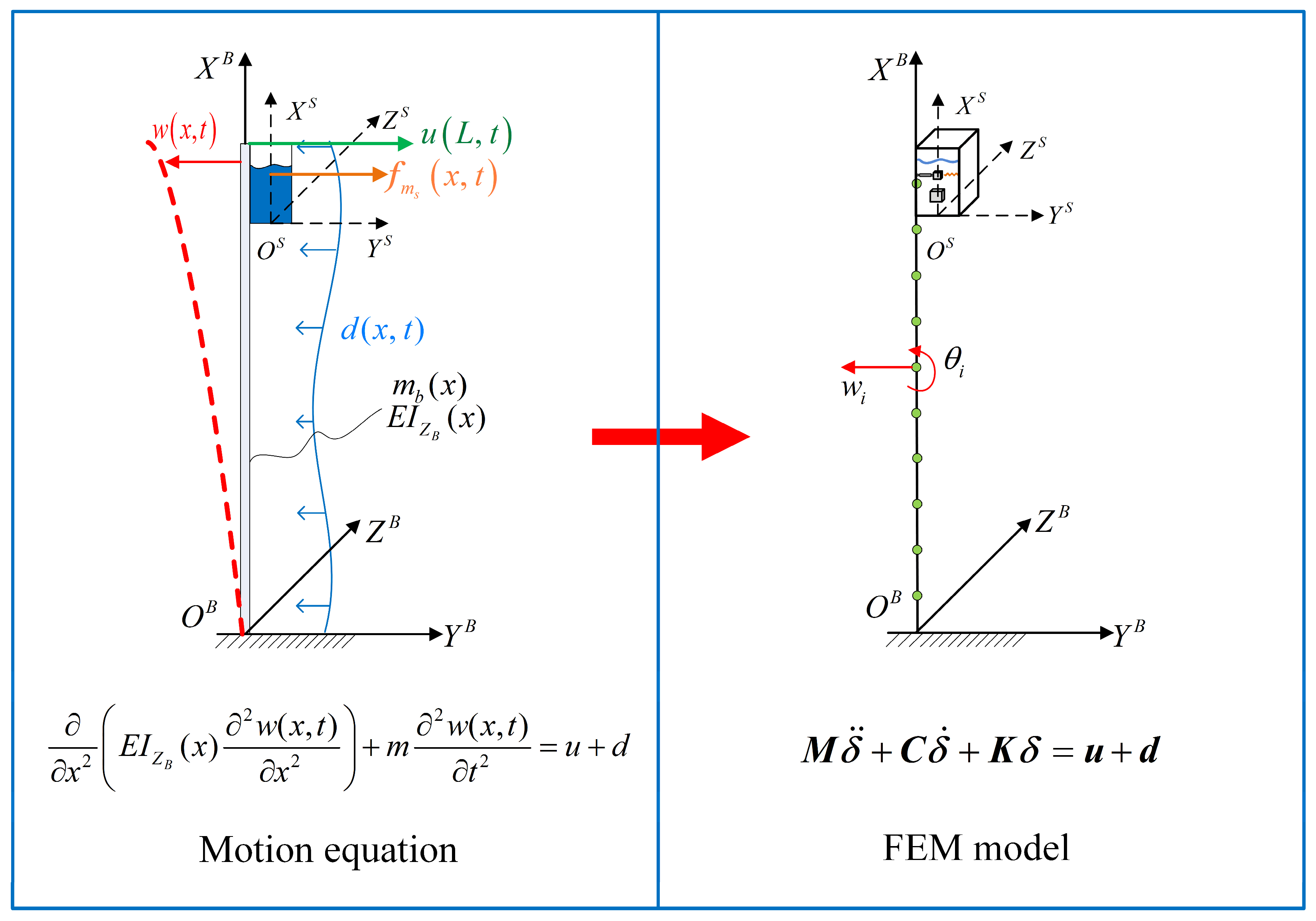
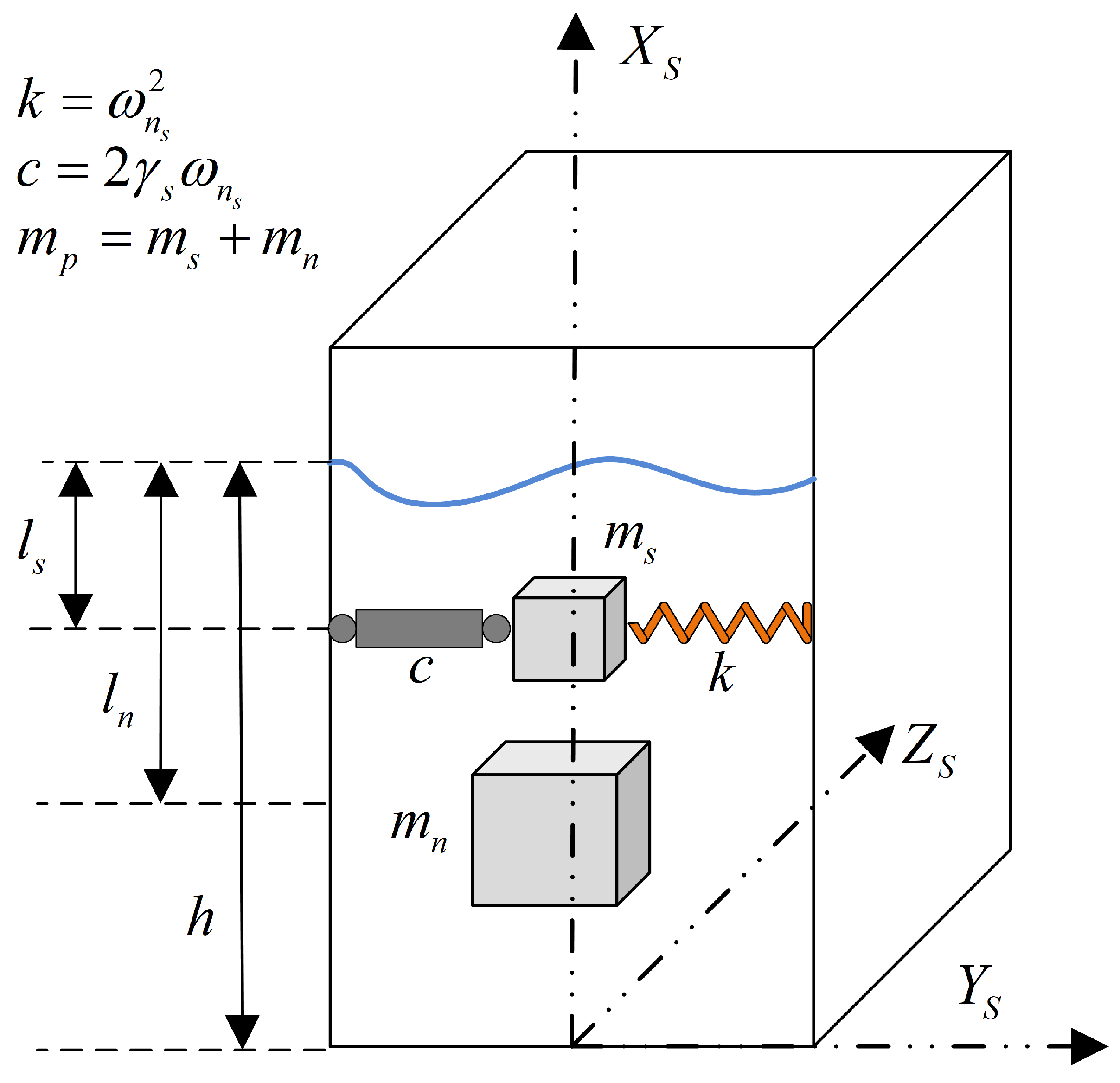
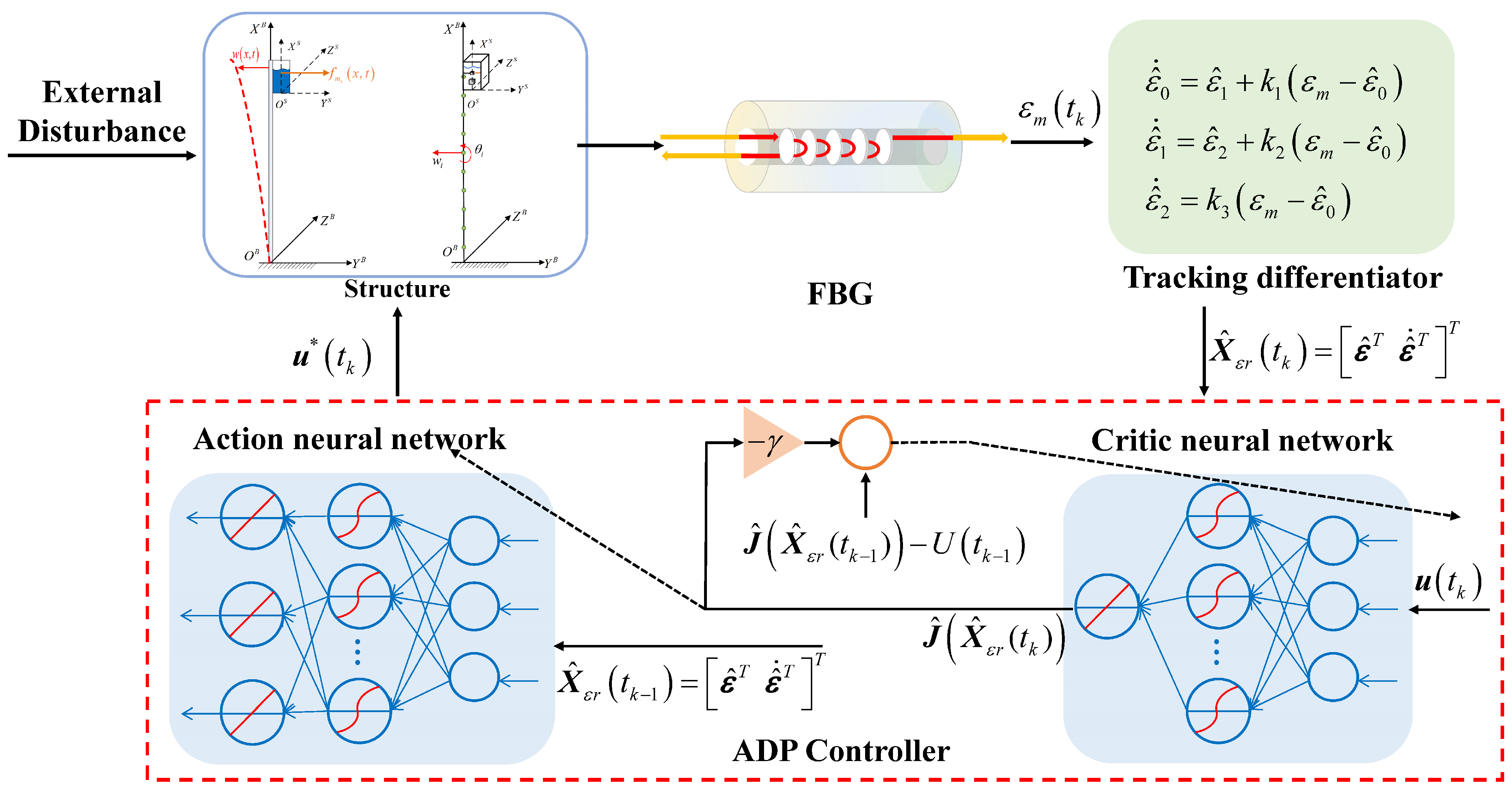
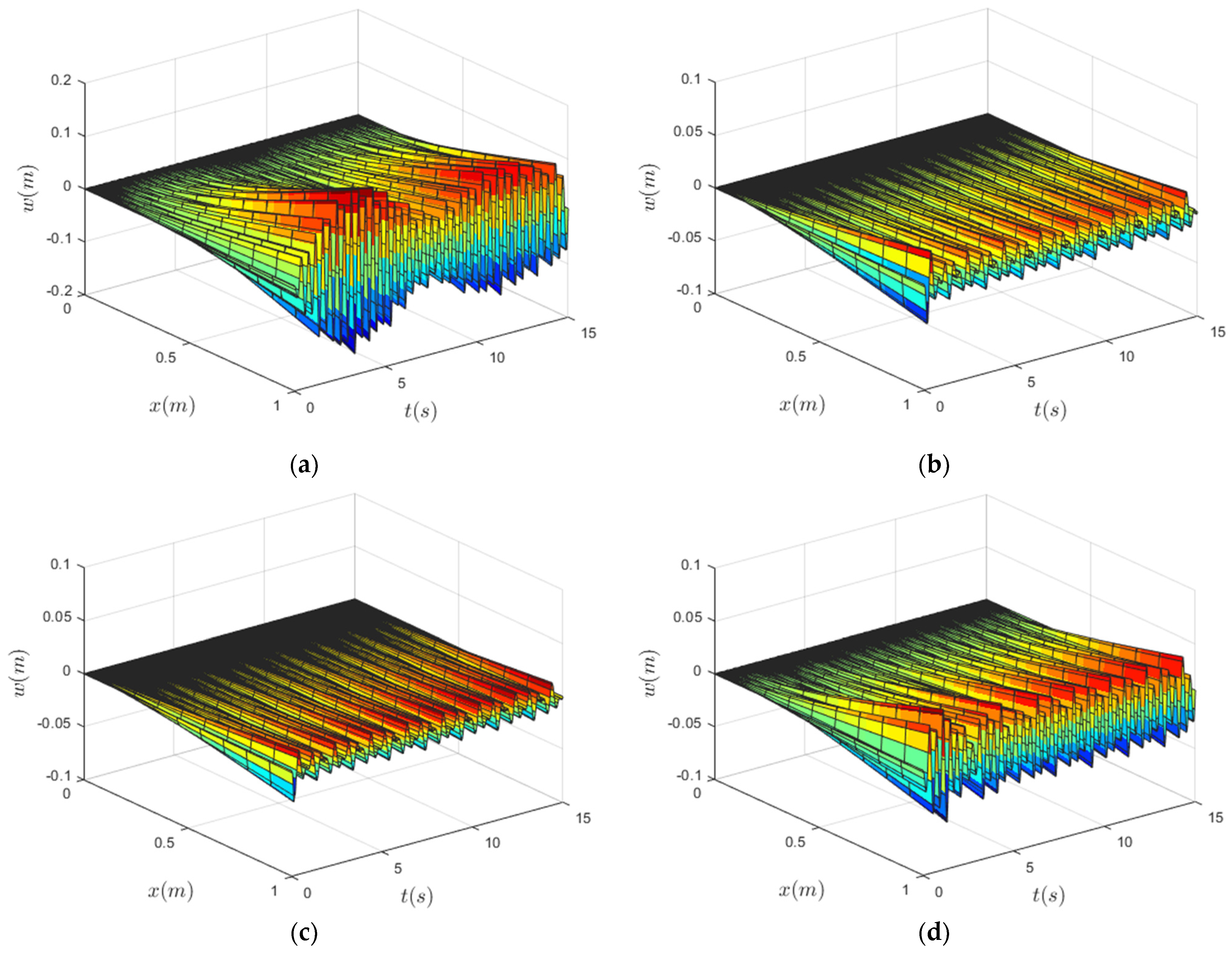
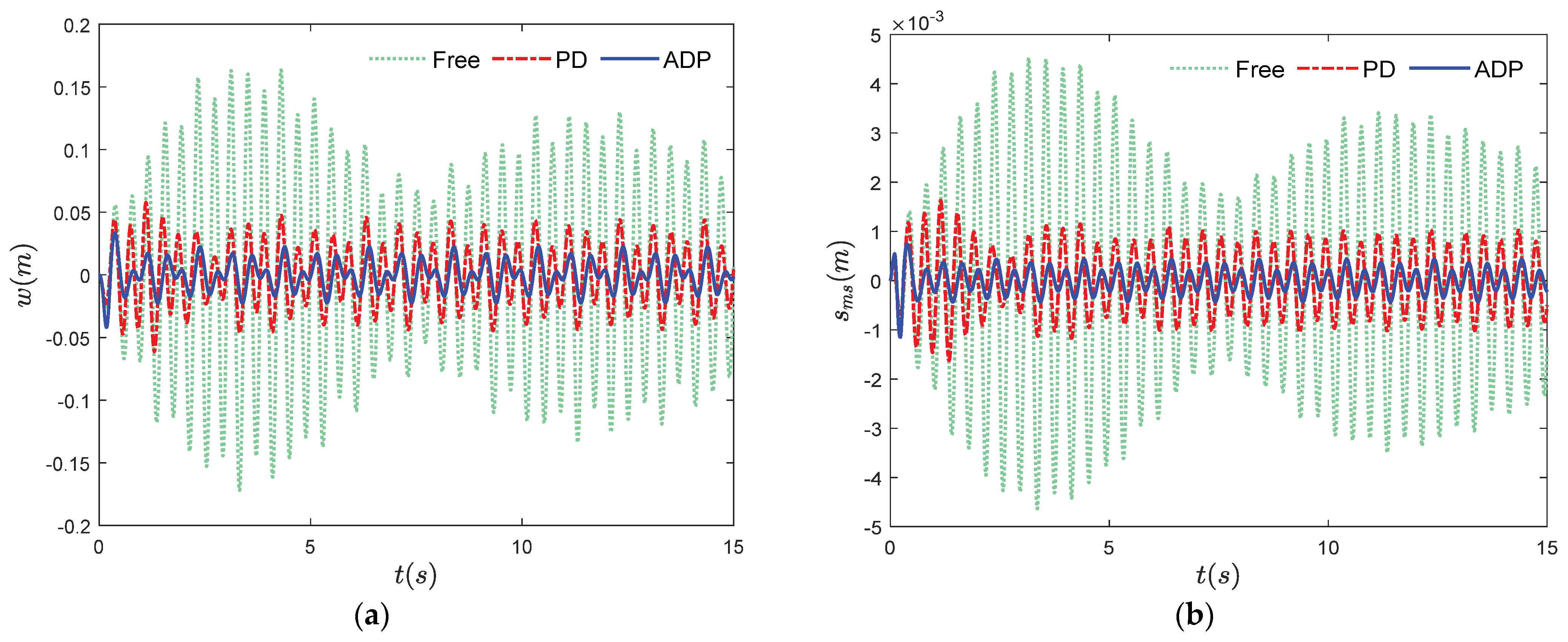
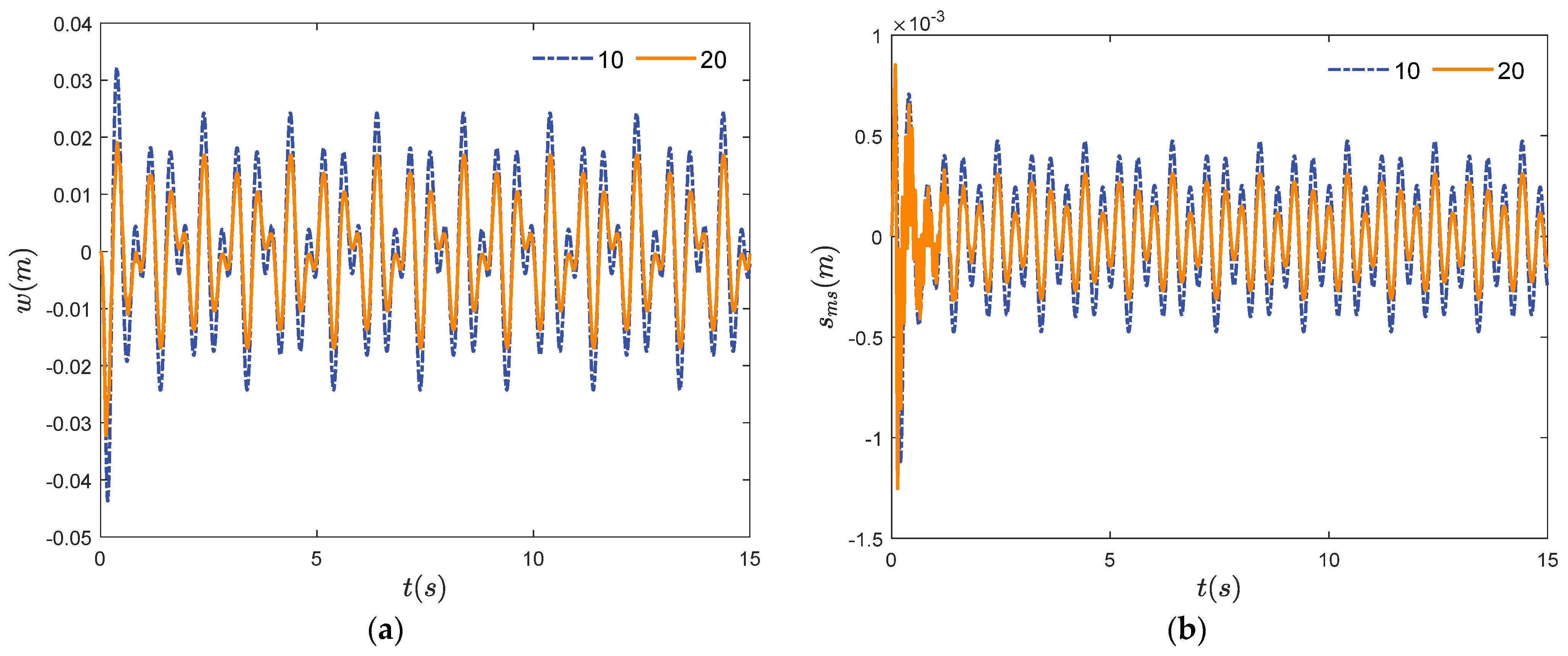
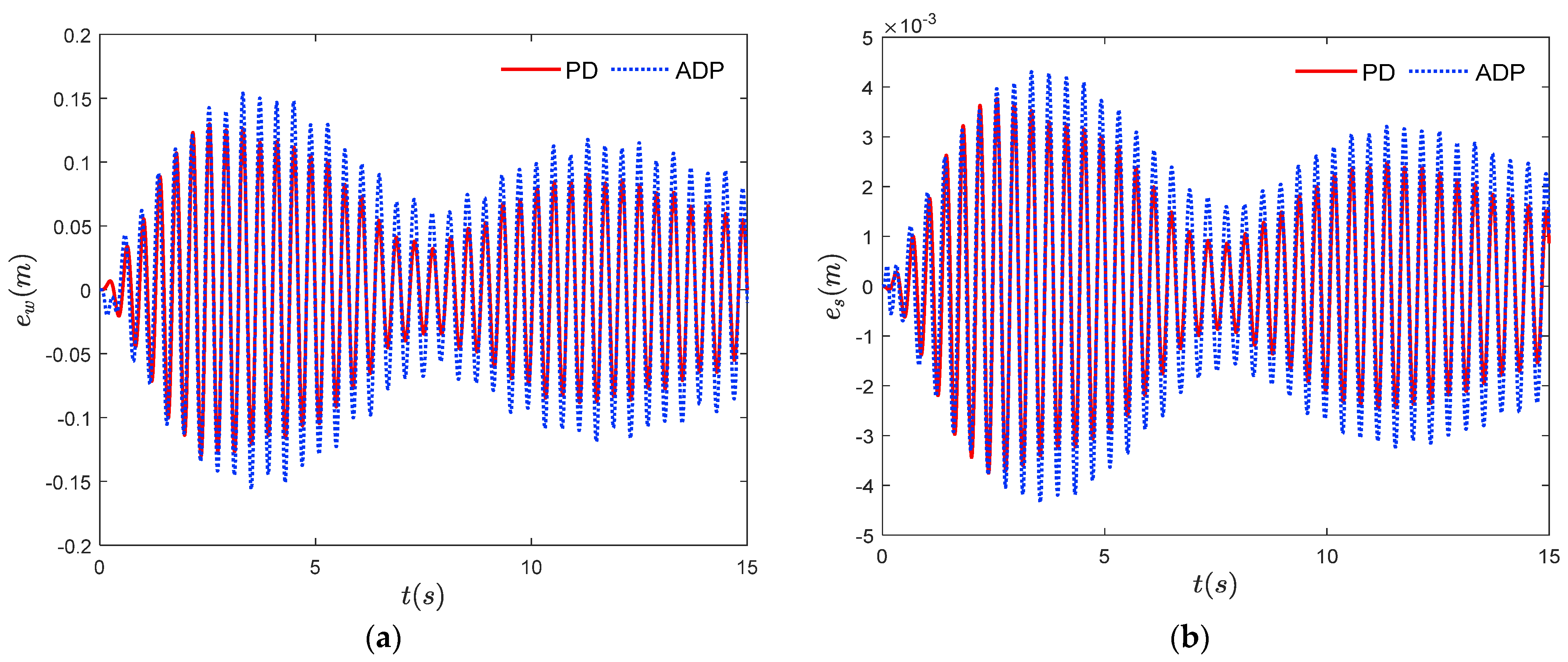
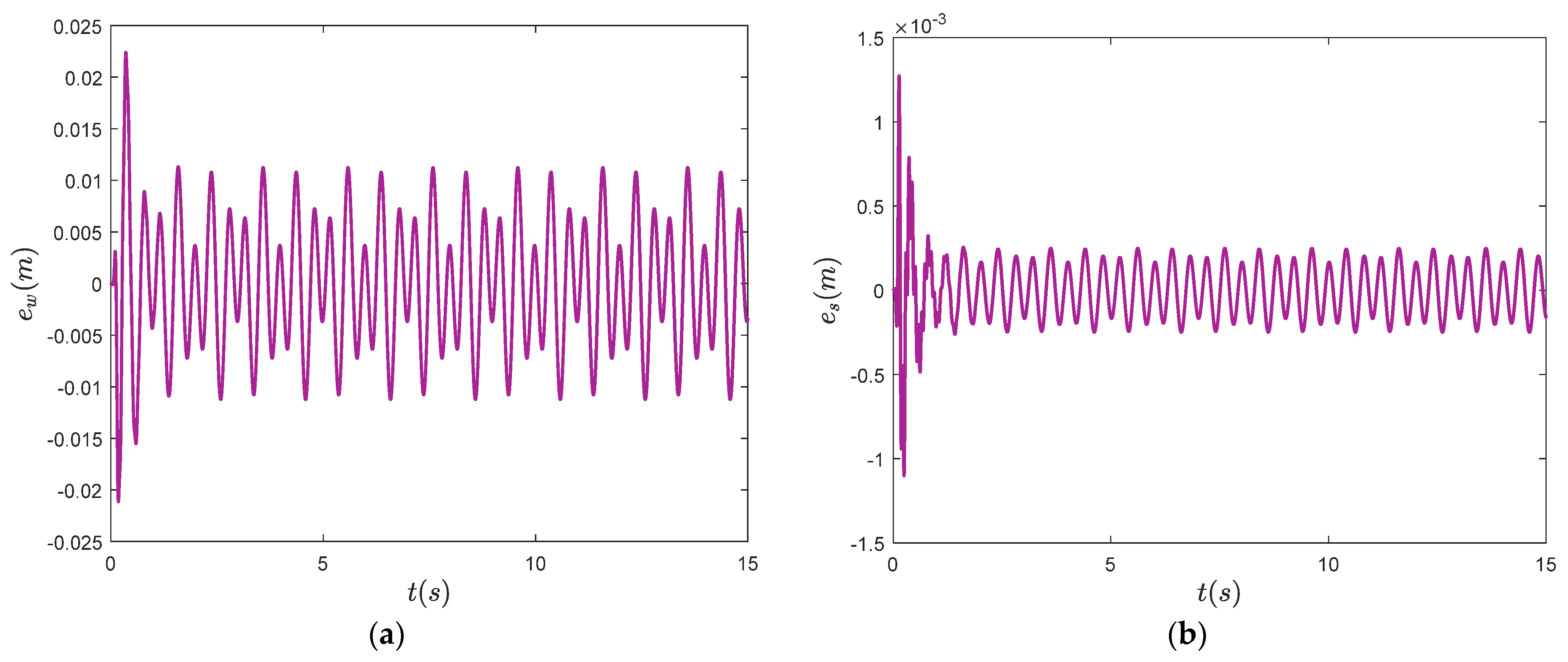
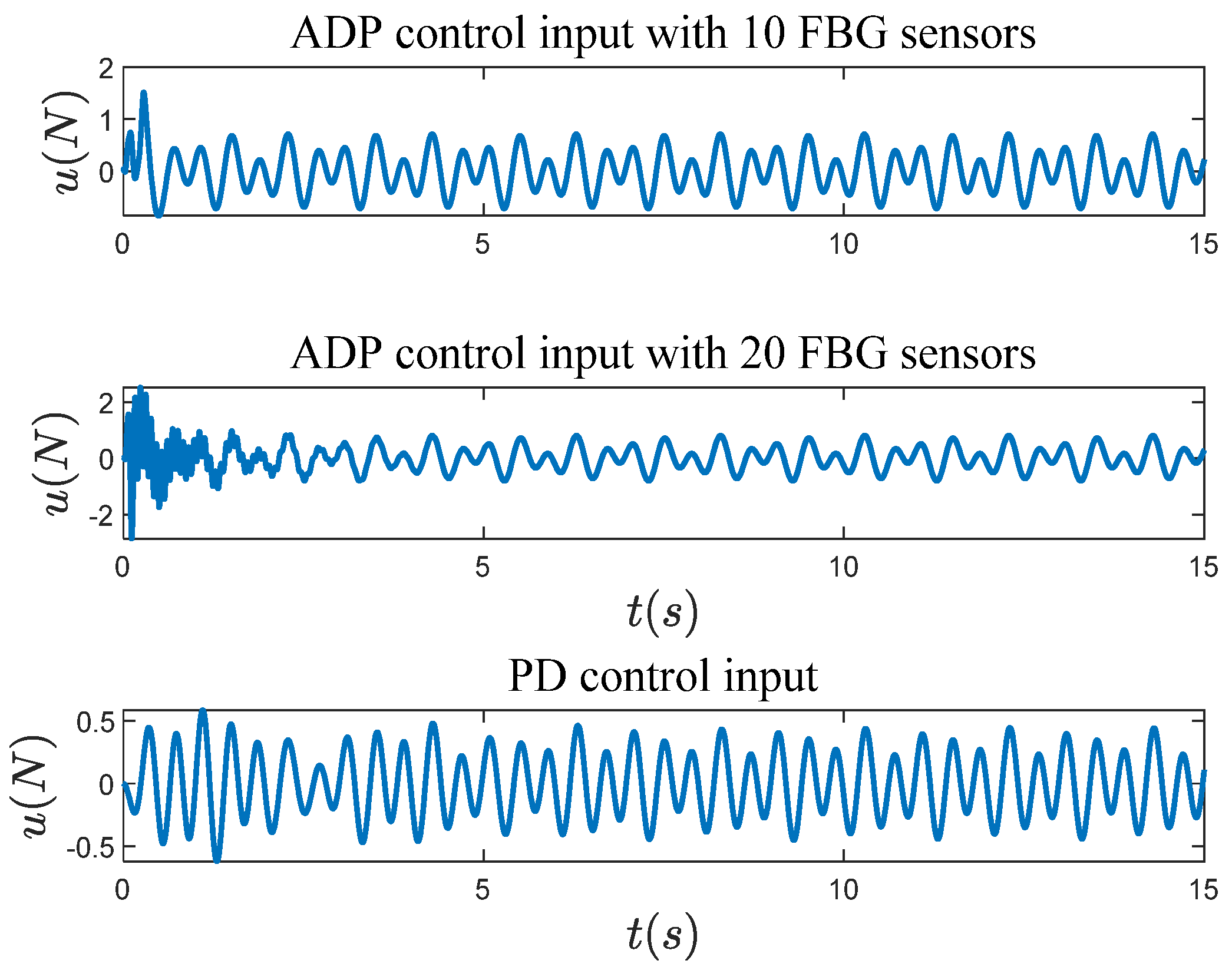
| Parameters | Value | |
|---|---|---|
| Aluminum alloy beam | Density (kg/m2) | 2690 |
| Elastic modulus (Pa) | 6.98e10 | |
| Length (m) | 0.972 | |
| Width (m) | 0.02 | |
| Height (m) | 0.003 | |
| Cuboid tank | Height of tank(m) | 0.1 |
| Length of bottom (m) | 0.04 | |
| Height of liquid level (m) | 0.04 | |
| Water | Density (kg/m2) | 1000 |
Disclaimer/Publisher’s Note: The statements, opinions and data contained in all publications are solely those of the individual author(s) and contributor(s) and not of MDPI and/or the editor(s). MDPI and/or the editor(s) disclaim responsibility for any injury to people or property resulting from any ideas, methods, instructions or products referred to in the content. |
© 2023 by the authors. Licensee MDPI, Basel, Switzerland. This article is an open access article distributed under the terms and conditions of the Creative Commons Attribution (CC BY) license (https://creativecommons.org/licenses/by/4.0/).
Share and Cite
Kong, C.; Zhao, D.; Liang, B. Vibration Suppression of a Flexible Beam Structure Coupled with Liquid Sloshing via ADP Control Based on FBG Strain Measurement. Actuators 2023, 12, 471. https://doi.org/10.3390/act12120471
Kong C, Zhao D, Liang B. Vibration Suppression of a Flexible Beam Structure Coupled with Liquid Sloshing via ADP Control Based on FBG Strain Measurement. Actuators. 2023; 12(12):471. https://doi.org/10.3390/act12120471
Chicago/Turabian StyleKong, Chunyang, Dangjun Zhao, and Buge Liang. 2023. "Vibration Suppression of a Flexible Beam Structure Coupled with Liquid Sloshing via ADP Control Based on FBG Strain Measurement" Actuators 12, no. 12: 471. https://doi.org/10.3390/act12120471





